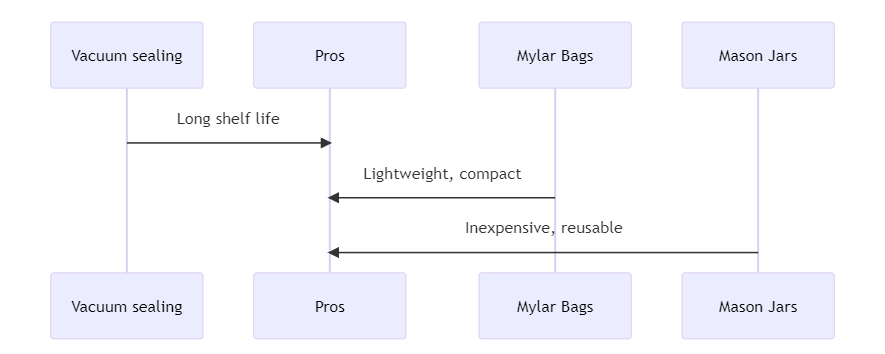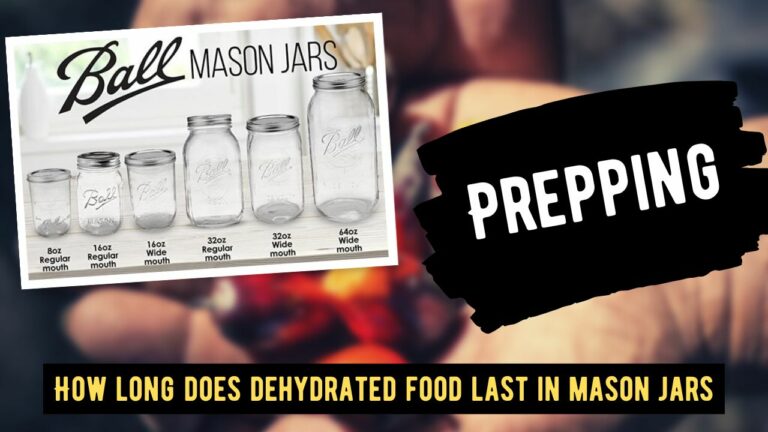Welcome to the fascinating world of dehydrated foods! Now, before you scroll past this article thinking “dehydrated foods sound about as exciting as watching paint dry”, hear us out.
Dehydrated foods are not just for survivalists and doomsday preppers (although they’re definitely great for that too). They’re an excellent option for anyone looking to store food for long periods of time, whether it’s because you’re stocking up on non-perishable goods during a sale, or because you’re planning a camping trip and don’t want to bring a fridge with you.
But before we dive into the nitty-gritty of dehydrated foods and how to store them, we need to address the elephant in the room: how long do dehydrated foods last? And more specifically, how long do they last when stored in mason jars?
Well, we’re here to give you all the answers. And trust us, you’re in for a real treat. Not only are dehydrated foods a delicious way to add some variety to your pantry, but they’re also super easy to store and can last for ages when stored properly.
Now that you know what you’re in for, let’s get started!
Factors Affecting the Shelf Life of Dehydrated Foods
Before we dive into the specifics of how long dehydrated foods last when stored in mason jars, it’s important to understand the factors that affect the shelf life of dehydrated foods in general.
First up, moisture content.
The key to preserving dehydrated foods for the long-term is, well, to dehydrate them. This means getting as much moisture out of the food as possible. If there’s still a lot of moisture left in the food, bacteria and mold can start to grow, which can greatly shorten the shelf life of the dehydrated food.
Next, we have exposure to air.
Oxygen can cause fats in the food to go rancid, which can greatly shorten the shelf life. This is why it’s important to store dehydrated foods in airtight containers.
Temperature is another factor to consider.
High temperatures can cause the fats in the food to go rancid, while low temperatures can cause moisture to condense inside the container, which can lead to the growth of bacteria and mold.
And lastly, we have light.
UV rays can cause the color of the food to fade, as well as cause the fats to go rancid. This is why it’s important to store dehydrated foods in containers that block out light.
The Role of Mason Jars in Storing Dehydrated Foods
Mason jars are an excellent option for storing dehydrated foods. Not only do they seal tightly, keeping out oxygen and UV rays, but they’re also made of thick glass which keeps the food safe from light. Plus, they’re easy to find, inexpensive, and can be used over and over again.
When storing dehydrated foods in mason jars, it’s important to make sure that the jars are completely sealed. A vacuum sealer can be used to remove all of the air from the jar and create a tight seal. Alternatively, you can use a lid with a rubber seal, like the ones typically used for canning, to create an airtight seal.
It’s also important to store the jars in a cool, dark place. This will help to slow down the process of oxidation and keep the dehydrated foods fresh for as long as possible.
Shelf Life of Dehydrated Foods in Mason Jars
So, now that we’ve covered the factors that affect the shelf life of dehydrated foods and how mason jars can be used to store them, it’s time to talk about the real question on everyone’s mind: how long do dehydrated foods last in mason jars?
The answer to this question can vary depending on the specific food and the storage conditions. Generally speaking, dehydrated foods that have been stored in an airtight container in a cool, dark place can last for 6 months to a year, or even longer in some cases.
It’s important to note that the shelf life of dehydrated foods can be affected by their moisture content. Foods that have been dehydrated to a lower moisture content will last longer than those with a higher moisture content.
When storing dehydrated foods in mason jars, it’s a good idea to include a “best by” or “use by” date on the jar, so that you know when to consume the food before it starts to go bad. It’s also a good idea to rotate your stock of dehydrated foods, using the oldest jars first to ensure that they are consumed before they expire.
Conclusion
In conclusion, when stored properly in mason jars, dehydrated foods can last for 6 months to a year or longer, making them a great option for long-term food storage. But don’t just take our word for it, give dehydrated foods a try and see for yourself how delicious and convenient they can be.
Wrapping up, dehydrated foods are a fantastic option for long-term food storage. They have a longer shelf life than fresh foods and take up less space, making them ideal for preppers, campers, and anyone looking to stock up on non-perishable goods.
When it comes to storing dehydrated foods, mason jars are a great option. They seal tightly, keeping out oxygen, light, and UV rays, while also being inexpensive and easy to find.
We hope this article has provided you with valuable information on the shelf life of dehydrated foods and how to store them in mason jars. We encourage you to give dehydrated foods a try and see for yourself how delicious and convenient they can be. As always, we remind you to be aware of the “best by” or “use by” date and to rotate your stock of dehydrated foods to ensure that they are consumed before they expire. Happy dehydrating!
Additional Resources
We hope this article has been informative and helpful, but we understand that sometimes you may want more information on a particular topic. Therefore, we have provided a list of additional resources for you to learn more about dehydrated foods and mason jar storage.
- The National Center for Home Food Preservation (NCHFP) provides detailed information on how to dehydrate foods, store them and rehydrate them for consumption. The website offers a wide variety of resources including guides, tutorials and FAQs that you might find useful.
- The Ball Corporation, manufacturers of the original and most popular brand of Mason jars offers a wide variety of information and recipes on their website including canning and preserving instructions.
- The Prepper’s Cookbook: 300 Recipes to Turn Your Emergency Food into Nutritious, Delicious, Life-Saving Meals is a great resource for those who are interested in prepping and emergency preparedness. The book includes recipes and instructions for dehydrating foods and storing them in mason jars.
- The Dehydrator Bible: Includes over 400 Recipes is a comprehensive guide to dehydrating food and includes recipes for both sweet and savory dishes.
- Dehydrating for Dummies: A beginner’s guide to dehydrating food and enjoying the fruits of your labor, can also be a great resource for those new to dehydrating foods and looking for guidance.
By consulting these resources, you can be sure to have a deeper understanding of the topic and be able to implement the best practices for storing dehydrated foods in mason jars, making sure your food will last as long as possible.
Diagrams or Illustrations
Visual aids can be very helpful when it comes to understanding the process of dehydrating food and how to store it in mason jars.
- A flowchart demonstrating the process of dehydrating food using a dehydrator:

- A flowchart illustrating the different storage methods for dehydrated foods and the pros and cons of each:

- A flowchart showing the steps of sealing a mason jar correctly:

